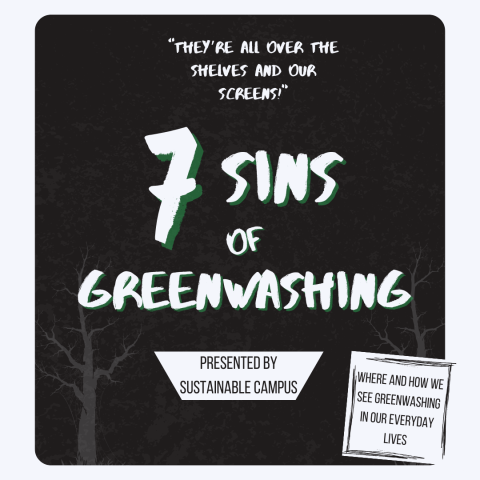Spooky Sustainability - Seven Deadly Sins of Greenwashing

They’re all over the shelves and our screens. From products in the grocery store labeled “All Natural” with no elaboration to commercials filled with images of trees and rivers for natural gas companies, “greenwashing” has infiltrated our advertising world. Greenwashing is a term that refers to making practices, policies, or products appear to be more environmentally friendly than they actually are. There are many ways companies can do this. Sometimes, companies can use visual cues to greenwash. This includes layering commercials with “green” pictures of nature to trick the viewer's mind into associating the product with nature, even though the two may be entirely unrelated. Text and content can also be culprits of greenwashing. This can be claiming a product is “100% Green” with no elaboration–a term with no legal definition that could mean anything, or cars describing themselves as using “green fuel.”
To combat this, the “Seven Deadly Sins of Greenwashing” were developed by Terrachoice in 2007, an environmental marketing and private consulting agency. These were developed as a simple way to understand the term and help consumers identify misleading environmental claims posed by businesses or governments. Once you start learning them, you may start to notice them everywhere! Below is a breakdown of all seven sins, including some examples to help identify where and how we may see greenwashing in our everyday lives.
- The Hidden Trade-Off
- The “Hidden Trade-Off” is when products advertise their sustainable practices without disclosing other deeply unsustainable practices. Basically using one practice to hide the others. This includes such things as talking about using recycled material without mentioning high water usage in manufacturing, or flaunting low energy use to make a product without mentioning the usage of environmentally hazardous materials to reach that low energy threshold.
- No Proof
- This is when companies make environmental claims without solid backing evidence. These are incredibly misleading to consumers. Products might say “sustainably sourced!” and never elaborate anywhere in their publicly accessible information on what that really means. This can also involve the presentation of a product (i.e. commercials) and the imagery associated with the product. For example, natural gas commercials talking over images of trees, bright blue skies, and running rivers convincing your mind to associate their product with those images, even if it has no proof of a positive natural connection.
- Vagueness
- Vagueness in greenwashing involves broad and loosely defined statements that can be easy to misinterpret. This often overlaps with Sin #2, “No Proof.” Examples include products made with “natural” materials without specification, which would still easily include hazardous materials, or products only labeled “green” products. Both are statements that by legal definition could mean anything or nothing, as terms such as “green” and “sustainable” have no official definition when it comes to advertising claims.
- Worshiping False Labels
- “Worshiping False Labels” is when companies essentially make up sustainability certifications, often by not attaching the claims to a known brand. For example, products claiming to be “Energy Efficiency Certified” or “100% Organic Certified” with no third-party certification (i.e. Energy Star, Fairtrade, Organic Association etc.) attached to the claim. With no third party attached, this may mean nothing. Trusted certifications to look for are Fairtrade, Energy Star, Organic Association, Monterey Bay Seafood Watch, and more.
- Irrelevance
- Sometimes, environmental claims about a product are true, they just… don’t mean anything. Such as aerosol sprays claiming to be “CFC-Free.” Chlorofluorocarbons were banned 30 years ago with the Montreal Protocol, and all aerosols should legally be CFC-free. They are no more green than their competitors for that claim, but it may sound like they are at first glance.
- The Lesser of Two Evils
- The “Lesser of Two Evils” can be used to make an inherently environmentally damaging product seem “less bad.” For example, cars that claim to use “greener fuel” or “mild hybrids” don’t detract from the fact any car with an internal combustion engine is going to use high levels of fossil fuels and release high levels of greenhouse gasses and CO2.
- Fibbing
- As it sounds, “Fibbing” is just lying. It’s when entities make environmental claims that are simply untrue. Such as oil mining projects claiming to be “sustainable,” which also take advantage of the sin of being Vague (such as Shell’s advertisement about their Tar Sands operations in Canada in 2008) to create untruths.
Often, several of the sins work together to craft a singular misleading message. These messages are everywhere–from commercials to labels on products, even to governmental claims and promises. As consumers, it pays to be aware.. Often, sustainably labeled products are priced slightly higher as a result, and if you’re planning and able to pay the difference, make sure it’s for a legitimate claim. As sustainability continues to grow more mainstream, buzzwords and empty phrases are also going to grow more common. We as consumers carry power in the consumption and production cycles, and how items are made and delivered. We can have an impact with our buying choices, but to do so we have to know where to put our support, and what’s trying to take advantage of the average consumer’s increasing awareness without actually changing anything.
